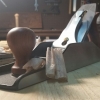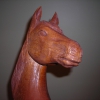
| 31 December 2017 11:43
Azucena - Sorry, can't help you specifically. However, with my own grinder I have bolted on a long metal strip between the two rests that come with the grinder, extending them out beyond the wheels. Simple to do. Works a treat!

| 30 December 2017 18:52
Hi Chris,
I'm looking for a tool rest that extends out a bit further than most to support/keep my hand steady while I'm shaping a gouge. Maybe a long shot question, but do you know the brand of the one you are using in this video? If not, any recommendation? Thanks!
Azucena

| 27 December 2013 14:08
Reginald - Slower speed is always a 'safer' option but wh not give both a try and find out which one feels more comfortable? The difference in time isn't too significant, really - remember you are only grinding once -commissioning a new tool. Then it's maintenance with strops.

| 24 December 2013 18:43
Reginald - I'm sure that will do just fine. Despite the slower speed and cool wheel, you still want to keep checking the blade temperature. Have a look at the video 'When the edge turns blue'...

| 09 December 2013 19:33
Kelly - The Arkansas stones are very fine; they remove metal from the blade slowly, so it takes a really long time - as you have found out. You are not doing anything wrong; you just need a coarser stone, say a Coarse Norton India. You can buy these from DIY stores, where the coarse stone is often sold in 'Combination' with a finer stone - and this Combination stone will do; use the coarse side. You only need a cheap grinder if you decide to buy one, as you are only doing light work. Again, one from a DIY store will no doubt be quite adequate and will soon pay for itself in terms of time. Remember safety goggles and keeping your edge cool.

| 07 December 2013 20:41
Hi Chris, I have a bevel on a gouge that is way too high and I do not have a grinder. I have been working on the angle with a soft Arkansas but the bevel is still very high. What am I doing wrong cause I am no where close to getting to the lower angle. Thanks!

| 08 July 2013 07:43
Christopher - If you can keep the blades cool, then the high speed is much quicker. I've round over one of the wheels on my grinder to form the inside bevels on the bigger tools, keeping the other wheel for the outside bevel. The slipstones have been around a while now. Try Classic Hand Tools (UK) or Tools for Working Wood (USA). Also download the Sharpening Notes from the download page: you'll see that grinders are really only for the initial big metal removal (shaping); you need fine stones, whatever they are, for the sharpening to a final edge. All those tools! Don't forget that they are only a means to an end, Just work on a few at a time - the most useful - and get carving, sharpening others as you need them.

| 08 July 2013 04:06
Chris - I really like the idea of using the bench grinder for putting the back bevel on the tool. I have a Tormek T3 and a variable speed 6" bench grinder at the moment. I got both to try and speed up the sharpening process as I just purchased 74 carving tools at half off (which saved me about $3000) so I could not pass this kind of deal up. So my question is which one of these grinders can I really use to speed up the commissioning of these tools and should I only use it to provide the initial back bevel of the tool and hone and polish the edge with stones? Also where can I find the inside slip stones you used the create the inside bevel? I have never heard of this before but it seems very logical especially after watching the previous video.

| 13 March 2013 16:19
Justin - Good for you! I'm really pleased to hear you kept at it until you got it right. Persistence is a fine attribute for a carver to have. You'll find it gets easier and quicker each time you do it, until it's second nature. You carving will benefit from that confidence too. Thanks for sharing.

| 13 March 2013 03:02
Chris it wasn't as good as I thought, the edge wouldn't stay on. I had the angle too high on the Arkansas stone and essentially put another edge on the bevel at a different angle. I did it over and over until I got it. My tool is about 6mm shorter, but I got it, and it was definitely worth the metal. My whole bevel shines like a mirror now, the edge is perfect, and more importantly i feel confident enough to do it myself now. Thanks a ton for this site.

| 11 March 2013 19:23
Justin - I'd use the, 'if it ain't broke, don't fix it' rule. Use it and eventually as you re-sharpen it will disappear. Well done for getting your gouge 'better than new'!

| 07 March 2013 04:06
Chris, I've followed this process to set an inside bevel and lower the cutting angle on a #2/12. All is well with the edge itself,(after 3 attempts) but there is a small dip near the heel on the blade, on the edge side. The tool seems to be working well, better than new actually, but is that little dip an issue? It's pretty small, just a part that isn't as shiny as the rest of the outside bevel.

| 14 September 2012 01:16
Doug - Grinders are very simple and you really don't need anything expensive, so a decent 6" bench grinder with a coarse and fine wheel from a hardware store will do. Make sure the wheels run true. And don't forget to cool your metal frequently as you work! As for the slipstones,google: Classic Hand Tools (UK) or Tools for Working Wood (USA)

| 13 September 2012 13:58
Chris,
Could you recommend a suitable bench grinder for someone like my self who is fairly new to wood carving. Also where do you get the slipstone set you refer to which has a variety of edges
Thanks
Doug Springate Sept 13th 2012

| 04 August 2012 19:37
I always thought my gouges were sharp enough, until I tried your method of sharpening! What a difference. I had a brand of tools that I never cared for. So I practiced on those to try out your method. Now I have some more gouges that I not only can use but enjoy using. Turns out it was just that the cutting angles were the problem. The angles on some of the cutting angles looked as if they were at 45 degrees. Thank you so much for starting this sight! It has helped me so much. Jim

| 02 August 2012 04:59
Peter - I agree: in theory, it's a better option for keeping a bevel flat than the wheel. However, my experience is that they are really designed for wide blades, especially those from planes. Narrow carving bevels wear grooves into the flat face very quickly and flattening the surface is quite time consuming compared with dressing the edge of a wheel. So, given that it's simple to turn your blade 90 deg. to the wheel and have a geometrically flat surface to work with, I've always gone for the (much cheaper) bench grinder. Actually, a machine with an abrasive belt that runs over a flat plate is a good alternative. A machine I use with a belt (Hegner) isn't made any more, but there must be others 'out there' worth investigating. (If anyone knows of any, please write me off-comment using the contact us form in the About section - thanks)

| 31 July 2012 16:41
Hi Chris: Enjoyed the sharpening video immensely. However, I just picked up 20 chisels on eBay which apparently were used for stone carving and needed regrinding with a lower angle. I applied what I learned in the video with some degree of success but with a lot of variable angles when I finished. I was wondering what your opinion is about the flat tool sharpeners where the disk spins horizontally (such as the Work Sharp 3000)? It seems like it would be easier to hold the tool at the proper angle as the disk spun toward it. Your thoughts please.
By the way û you guys are doing a great job with the Olympics.
Thanks much.
Peter